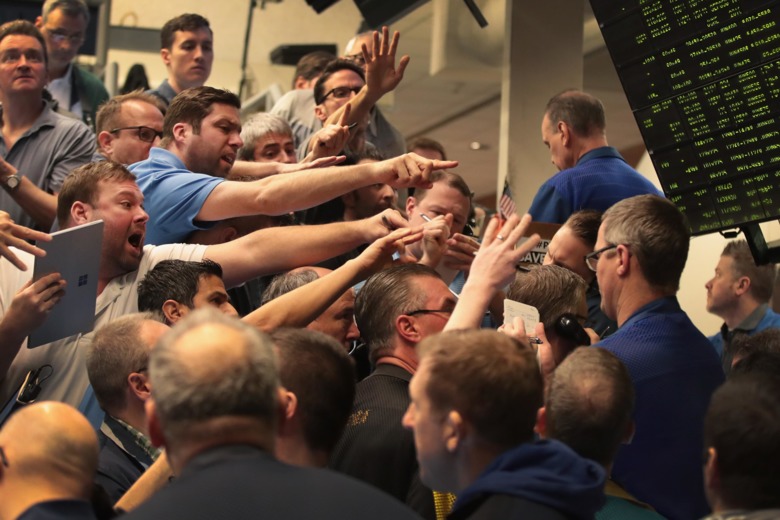
On Monday, stocks got clobbered. Tuesday, they’ve been twitchy—fluctuating up and down like the needle on a seismograph.
Why are traders in such a jittery mood? After a long period of unusual calm, investors are suddenly grappling with the possibility that the market will be a much more volatile place going forward. That realization, in turn, seems to have been driving much of the stock-market drama these past few days.
In other words, Wall Street mostly seems to be afraid of fear itself.
For the past couple of years, stocks have been enjoying something of a Goldilocks moment. Profits have been strong, growth has been reasonable, and inflation has been basically nonexistent, meaning that the Federal Reserve didn’t have any reason to make sudden, disruptive changes to interest rates. All of this helped create an environment where stock prices could steadily rise while volatility—the amount that share prices tend to swing up or down at a time—stayed historically low. The S&P 500 had its least volatile performance in 53 years during 2017, and investors expected smooth waters ahead, too. The CBOE Volatility Index, or VIX—which is supposed to track the market’s expectations of future choppiness—stayed so low for so long that some market watchers started getting nervous about complacency. As Bloomberg’s Matt Levine liked to put it, people were worried that people weren’t worried enough.
Now the markets are suddenly feeling much less chill. The trouble seemed to start in earnest on Friday morning, after the monthly jobs report finally showed wage growth picking up its pace. This raised the possibility that faster inflation might also be around the corner, making it more likely that the Federal Reserve would raise interest rates to head it off. Stocks quickly began to sell off, which made reasonable sense since higher interest rates should, in fact, be bad for share prices. There are few reasons why. For one, they mean higher borrowing costs for companies, which could cut into profits or put a damper on growth. They also make boring-but-safe investments like Treasury bonds or AAA corporate debt more attractive compared with riskier assets like stocks, which could draw investment dollars out of the equity markets and into debt.
Finally, rising interest rates may also make the markets more volatile. As Linette Lopez wrote at Business Insider, the world’s central banks have spent the better part of decade now keeping interest rates close to zero. That’s beginning to change, and it will require an adjustment period for markets during which things could get choppy. This is the realization that, by Monday, seemed to drive much of the topsy-turvy trading . The VIX, often referred to as the market’s “fear index,” spiked, making its biggest absolute one-day move in history.
That sudden surge had knock-on effects that may have played a big role in driving stock prices lower Monday and sending them bouncing around Tuesday. During the recent years of calm, many traders placed bets that volatility would remain low for at least the short-term. They purchased products like the VelocityShares Daily Inverse VIX Short-Term ETN, a note issued by Credit Suisse that was designed to go up in value when the VIX went down (hence its ticker, XIV). Those wagers are suddenly losing quite a bit of money—the carnage has been so bad that trading had to pause on many products that were pegged to volatility levels. Some investors who got caught in that bloodbath are likely being forced to sell stocks to deal with their losses.
Perhaps more importantly, certain kinds of investment funds are programmed to move into less risky assets when volatility picks up, leading them to unload stocks. Much of that action takes place automatically, thanks to algorithmic trading. In a note to clients Monday, JPMorgan Chase’s chief quantitative analyst argued that those strategies helped trigger the later afternoon flash crash on Monday. In short, even computers are suddenly getting a bit worried.
Is all this fear over fear justified? Maybe, maybe not. The important thing to keep in mind that, insofar as anything has actually changed (and it’s possible all of this is a momentary blip we’ll forget about in a few weeks), the financial markets seem to be in a transitional moment that doesn’t really reflect any problems with the real economy. In fact, their current rockiness may reflect the economy’s growing strength and the possibility that the Federal Reserve will put an end to Wall Street’s long stretch of low-interest serenity. For most of us, that’s probably not something to be overly worried about.

